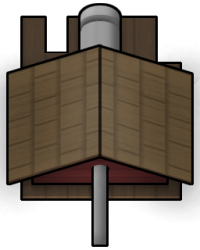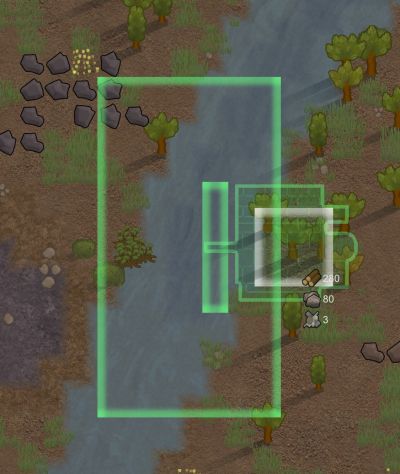Difference between revisions of "Watermill generator"
(→Acquisition: wind turbines -> watermill generators) |
m (→Summary: rephrase) |
||
| Line 32: | Line 32: | ||
==Summary== | ==Summary== | ||
The watermill generator produces a constant 1100W after construction. The watermill generator is unique in that it requires two different types of terrain: heavy and moving water. | The watermill generator produces a constant 1100W after construction. The watermill generator is unique in that it requires two different types of terrain: heavy and moving water. | ||
| + | |||
| + | The base is a 3x3 square in the middle of the housing; the housing extends another 1 square beyond that, making a 5x5 square. Then the 1x5 waterwheel is attached to one side of the housing (your choice), making the total footprint <u>5x6</u>. Only the 3x3 base must be on firm ground, the rest of the housing may be over water. | ||
A watermill generator must be placed: | A watermill generator must be placed: | ||
| − | #with its | + | # with its 3x3 base on tiles that can support Heavy (i.e. on solid ground, not on a bridge or marsh) |
| − | + | # with its water wheel entirely in moving water | |
| − | #with neither its housing nor wheel overlapping any other buildings or walls | + | # with neither its housing nor wheel overlapping any other buildings or walls |
| − | |||
| − | |||
When placing the watermill generator, the blueprint will show: | When placing the watermill generator, the blueprint will show: | ||
| − | + | * The 3x3 base of the generator (in white) | |
| − | + | * The 5x5 housing of the generator (green if placeable, red if not) | |
| − | + | * The 1x5 waterwheel of the generator off one side of that (green if placeable, red if not) | |
| − | + | * The (semi-)exclusion zone, explained below (blue on previously built watermills, green if OK, flashing orange if overlapping) | |
<gallery widths="400px" heights="800px" class="center" mode="nolines"> | <gallery widths="400px" heights="800px" class="center" mode="nolines"> | ||
| − | File:Watermill-placement- | + | File:Watermill-placement-OK.jpg|Good placement of watermill; green housing, wheel and exclusion zone. Note base (white) on firm ground but housing partially over water. |
| − | File:Watermill-placement- | + | File:Watermill-placement-not_OK.jpg|Watermill placement not allowed (red housing & wheel, from overlapping wall), and exclusion zone overlapping (orange warning re -70% power penalty). Base in white. |
</gallery> | </gallery> | ||
| − | Power output does not depend on water tiles covered. However, the output of watermills will be reduced to 30% (330W) if you overlap their exclusion zones. The exclusion zones are 13x7 rectangles, extending 4 squares above, below and outside the mill. If you wish to build multiple maximally efficient watermills, they will need to be spread out a bit making them slightly harder to defend than most other power generating systems. | + | Power output does not depend on water tiles covered. However, the output of watermills will be reduced to 30% (330W) if you overlap their exclusion zones. The exclusion zones are 13x7 rectangles, extending 4 squares above, below and outside the mill. If you wish to build multiple maximally efficient watermills, they will need to be spread out a bit, making them slightly harder to defend than most other power generating systems. |
The 30% reduction does not stack, so given a sufficiently straight river, an alternative strategy to maximize power output would be to cram as many watermill generators as possible along both sides of the river bank. | The 30% reduction does not stack, so given a sufficiently straight river, an alternative strategy to maximize power output would be to cram as many watermill generators as possible along both sides of the river bank. | ||
Revision as of 09:37, 18 January 2022
Watermill generator
Produces electricity from a river. Must be placed with its wheel in moving water. If watermills are placed too close together, the turbulence they generate will interfere and reduce power generation.
Base Stats
Building
- Size
- 5 × 6
- Minifiable
- False
- Placeable
- True
- Passability
- impassable
- Cover Effectiveness
- 75%
- Blocks Wind
- True
- Power
- 1100 W
Creation
- Required Research
- Watermill generator
- Skill Required
- Construction 6
- Work To Make
- 4,000 ticks (1.11 mins)
Watermill generators are built on moving water to generate a constant 1100W of power, regardless of weather or other conditions.
Acquisition
Watermill generators can be constructed once Watermill Generator has been researched. Each one requires ![]() 280 Wood,
280 Wood, ![]() 80 Steel,
80 Steel, ![]() 3 Components, and a Construction skill of 6.
3 Components, and a Construction skill of 6.
Summary
The watermill generator produces a constant 1100W after construction. The watermill generator is unique in that it requires two different types of terrain: heavy and moving water.
The base is a 3x3 square in the middle of the housing; the housing extends another 1 square beyond that, making a 5x5 square. Then the 1x5 waterwheel is attached to one side of the housing (your choice), making the total footprint 5x6. Only the 3x3 base must be on firm ground, the rest of the housing may be over water.
A watermill generator must be placed:
- with its 3x3 base on tiles that can support Heavy (i.e. on solid ground, not on a bridge or marsh)
- with its water wheel entirely in moving water
- with neither its housing nor wheel overlapping any other buildings or walls
When placing the watermill generator, the blueprint will show:
- The 3x3 base of the generator (in white)
- The 5x5 housing of the generator (green if placeable, red if not)
- The 1x5 waterwheel of the generator off one side of that (green if placeable, red if not)
- The (semi-)exclusion zone, explained below (blue on previously built watermills, green if OK, flashing orange if overlapping)
Power output does not depend on water tiles covered. However, the output of watermills will be reduced to 30% (330W) if you overlap their exclusion zones. The exclusion zones are 13x7 rectangles, extending 4 squares above, below and outside the mill. If you wish to build multiple maximally efficient watermills, they will need to be spread out a bit, making them slightly harder to defend than most other power generating systems.
The 30% reduction does not stack, so given a sufficiently straight river, an alternative strategy to maximize power output would be to cram as many watermill generators as possible along both sides of the river bank.
Bridges do not interfere with power generation if built within the generator's exclusion zone.
Analysis
| This section is a stub. You can help RimWorld Wiki by expanding it. Reason: Please add a reason . |
Version history
- 0.19.2009 - Added.


